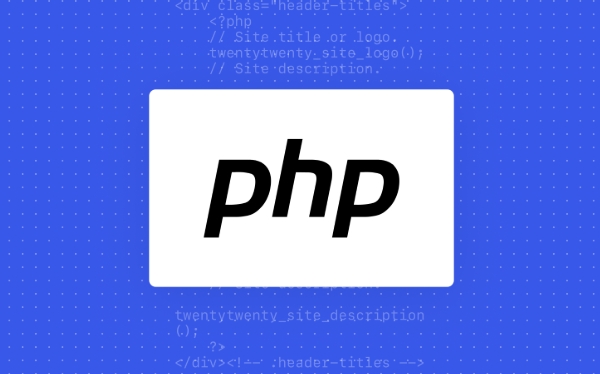 Backend Development
Backend Development
 PHP Tutorial
PHP Tutorial
 Functional Programming Paradigms with PHP's Associative Arrays
Functional Programming Paradigms with PHP's Associative Arrays
Functional Programming Paradigms with PHP's Associative Arrays
Aug 03, 2025 pm 04:18 PMUse immutable arrays by returning new arrays instead of modifying originals; 2. Apply higher-order functions like array_map, array_filter, and array_reduce for clean transformations; 3. Chain operations using nested calls or a Collection class to create functional pipelines; 4. Write pure functions with closures to avoid side effects and enhance reusability; overall, PHP supports functional programming with associative arrays through disciplined use of these techniques, improving code clarity and maintainability.

PHP is often seen as a procedural or object-oriented language, but it can also support functional programming (FP) paradigms—especially when working with associative arrays. While PHP wasn’t designed from the ground up for functional programming like Haskell or Clojure, it offers enough tools (closures, higher-order functions, immutability patterns) to apply key FP concepts effectively.

Here’s how you can use functional programming techniques with PHP’s associative arrays.
1. Immutability and Pure Functions
In functional programming, data should not be mutated. Instead of modifying an associative array in place, return a new one.

Bad (mutation):
$user = ['name' => 'Alice', 'age' => 30]; $user['active'] = true; // Mutates original
Better (immutability):

function withActiveStatus(array $user): array {
return ['active' => true] $user; // New array, original unchanged
}
$user = ['name' => 'Alice', 'age' => 30];
$updatedUser = withActiveStatus($user);Using the operator merges arrays from right to left, preserving the original. This pattern encourages pure functions—functions that don’t cause side effects and always return the same output for the same input.
2. Higher-Order Functions: map, filter, reduce
PHP provides built-in functions that align well with FP: array_map, array_filter, and array_reduce. When used with associative arrays, they help transform, select, and aggregate data cleanly.
Transform with array_map
$users = [
['name' => 'Alice', 'age' => 30],
['name' => 'Bob', 'age' => 25]
];
$names = array_map(fn($user) => $user['name'], $users);
// Result: ['Alice', 'Bob']Note: array_map preserves keys, which is useful when working with indexed or keyed associative data.
Filter with array_filter
$adults = array_filter($users, fn($user) => $user['age'] >= 30); // Returns only users where age >= 30
You can also preserve keys (which is default), or reindex later with array_values() if needed.
Aggregate with array_reduce
$totalAge = array_reduce($users, fn($carry, $user) => $carry $user['age'], 0); // Result: 55
These functions avoid loops and make intent clearer—each expresses a specific transformation.
3. Chaining Operations (Functional Pipelines)
You can chain operations by nesting or using a fluent style. While PHP doesn’t have built-in method chaining for arrays, you can wrap arrays in a simple class or use nested function calls.
Example: Nested calls
$averageAdultAge = array_reduce(
array_filter($users, fn($u) => $u['age'] >= 30),
fn($carry, $u) => $carry $u['age'],
0
) / count(array_filter($users, fn($u) => $u['age'] >= 30));Alternatively, use a helper to enable chaining:
class Collection {
private array $items;
public function __construct(array $items) {
$this->items = $items;
}
public function map(callable $fn): self {
return new self(array_map($fn, $this->items));
}
public function filter(callable $fn): self {
return new self(array_filter($this->items, $fn));
}
public function reduce(callable $fn, $initial) {
return array_reduce($this->items, $fn, $initial);
}
public function toArray(): array {
return $this->items;
}
}
// Usage
$avg = (new Collection($users))
->filter(fn($u) => $u['age'] >= 30)
->map(fn($u) => $u['age'])
->reduce(fn($sum, $age) => $sum $age, 0);
$average = $avg / count(array_filter($users, fn($u) => $u['age'] >= 30));This mimics functional pipelines seen in JavaScript or Elixir.
4. Avoiding Side Effects and Using Closures
Closures in PHP (anonymous functions) are essential for FP. They can capture context and are first-class values.
function createGreeter(string $greeting) {
return fn($name) => "$greeting, $name!";
}
$sayHello = createGreeter("Hello");
$greetUsers = array_map($sayHello, $names);This avoids global state and promotes reusable, composable logic.
Also, avoid functions that modify external variables:
$counter = 0;
array_map(function ($item) use (&$counter) { $counter ; }, $array); // Impure!Instead, calculate counts functionally:
$count = array_reduce($array, fn($c, $i) => $c 1, 0);
Summary
You can apply functional programming principles in PHP with associative arrays by:
- Treating arrays as immutable
- Using
array_map,array_filter, andarray_reducefor transformations - Building pipelines through composition or wrapper classes
- Writing pure functions and avoiding side effects
- Leveraging closures for configurability and encapsulation
While PHP lacks some FP features (like pattern matching or lazy evaluation), these patterns improve code clarity, testability, and maintainability.
Basically, you don’t need a purely functional language to write functionally—just discipline and the right abstractions.
The above is the detailed content of Functional Programming Paradigms with PHP's Associative Arrays. For more information, please follow other related articles on the PHP Chinese website!

Hot AI Tools

Undress AI Tool
Undress images for free

Undresser.AI Undress
AI-powered app for creating realistic nude photos

AI Clothes Remover
Online AI tool for removing clothes from photos.

Clothoff.io
AI clothes remover

Video Face Swap
Swap faces in any video effortlessly with our completely free AI face swap tool!

Hot Article

Hot Tools

Notepad++7.3.1
Easy-to-use and free code editor

SublimeText3 Chinese version
Chinese version, very easy to use

Zend Studio 13.0.1
Powerful PHP integrated development environment

Dreamweaver CS6
Visual web development tools

SublimeText3 Mac version
God-level code editing software (SublimeText3)

Hot Topics
 PHP Variable Scope Explained
Jul 17, 2025 am 04:16 AM
PHP Variable Scope Explained
Jul 17, 2025 am 04:16 AM
Common problems and solutions for PHP variable scope include: 1. The global variable cannot be accessed within the function, and it needs to be passed in using the global keyword or parameter; 2. The static variable is declared with static, and it is only initialized once and the value is maintained between multiple calls; 3. Hyperglobal variables such as $_GET and $_POST can be used directly in any scope, but you need to pay attention to safe filtering; 4. Anonymous functions need to introduce parent scope variables through the use keyword, and when modifying external variables, you need to pass a reference. Mastering these rules can help avoid errors and improve code stability.
 How to handle File Uploads securely in PHP?
Jul 08, 2025 am 02:37 AM
How to handle File Uploads securely in PHP?
Jul 08, 2025 am 02:37 AM
To safely handle PHP file uploads, you need to verify the source and type, control the file name and path, set server restrictions, and process media files twice. 1. Verify the upload source to prevent CSRF through token and detect the real MIME type through finfo_file using whitelist control; 2. Rename the file to a random string and determine the extension to store it in a non-Web directory according to the detection type; 3. PHP configuration limits the upload size and temporary directory Nginx/Apache prohibits access to the upload directory; 4. The GD library resaves the pictures to clear potential malicious data.
 Commenting Out Code in PHP
Jul 18, 2025 am 04:57 AM
Commenting Out Code in PHP
Jul 18, 2025 am 04:57 AM
There are three common methods for PHP comment code: 1. Use // or # to block one line of code, and it is recommended to use //; 2. Use /.../ to wrap code blocks with multiple lines, which cannot be nested but can be crossed; 3. Combination skills comments such as using /if(){}/ to control logic blocks, or to improve efficiency with editor shortcut keys, you should pay attention to closing symbols and avoid nesting when using them.
 How Do Generators Work in PHP?
Jul 11, 2025 am 03:12 AM
How Do Generators Work in PHP?
Jul 11, 2025 am 03:12 AM
AgeneratorinPHPisamemory-efficientwaytoiterateoverlargedatasetsbyyieldingvaluesoneatatimeinsteadofreturningthemallatonce.1.Generatorsusetheyieldkeywordtoproducevaluesondemand,reducingmemoryusage.2.Theyareusefulforhandlingbigloops,readinglargefiles,or
 Tips for Writing PHP Comments
Jul 18, 2025 am 04:51 AM
Tips for Writing PHP Comments
Jul 18, 2025 am 04:51 AM
The key to writing PHP comments is to clarify the purpose and specifications. Comments should explain "why" rather than "what was done", avoiding redundancy or too simplicity. 1. Use a unified format, such as docblock (/*/) for class and method descriptions to improve readability and tool compatibility; 2. Emphasize the reasons behind the logic, such as why JS jumps need to be output manually; 3. Add an overview description before complex code, describe the process in steps, and help understand the overall idea; 4. Use TODO and FIXME rationally to mark to-do items and problems to facilitate subsequent tracking and collaboration. Good annotations can reduce communication costs and improve code maintenance efficiency.
 Quick PHP Installation Tutorial
Jul 18, 2025 am 04:52 AM
Quick PHP Installation Tutorial
Jul 18, 2025 am 04:52 AM
ToinstallPHPquickly,useXAMPPonWindowsorHomebrewonmacOS.1.OnWindows,downloadandinstallXAMPP,selectcomponents,startApache,andplacefilesinhtdocs.2.Alternatively,manuallyinstallPHPfromphp.netandsetupaserverlikeApache.3.OnmacOS,installHomebrew,thenrun'bre
 How to access a character in a string by index in PHP
Jul 12, 2025 am 03:15 AM
How to access a character in a string by index in PHP
Jul 12, 2025 am 03:15 AM
In PHP, you can use square brackets or curly braces to obtain string specific index characters, but square brackets are recommended; the index starts from 0, and the access outside the range returns a null value and cannot be assigned a value; mb_substr is required to handle multi-byte characters. For example: $str="hello";echo$str[0]; output h; and Chinese characters such as mb_substr($str,1,1) need to obtain the correct result; in actual applications, the length of the string should be checked before looping, dynamic strings need to be verified for validity, and multilingual projects recommend using multi-byte security functions uniformly.
 Learning PHP: A Beginner's Guide
Jul 18, 2025 am 04:54 AM
Learning PHP: A Beginner's Guide
Jul 18, 2025 am 04:54 AM
TolearnPHPeffectively,startbysettingupalocalserverenvironmentusingtoolslikeXAMPPandacodeeditorlikeVSCode.1)InstallXAMPPforApache,MySQL,andPHP.2)Useacodeeditorforsyntaxsupport.3)TestyoursetupwithasimplePHPfile.Next,learnPHPbasicsincludingvariables,ech





